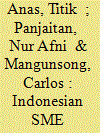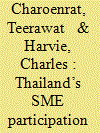| Srl | Item |
| 1 |
ID:
152288


|
|
|
|
|
| Summary/Abstract |
This study examines the extent and nature of Indonesia’s SMEs’ participation in ASEAN economic integration based on a survey of 200 SMEs in the manufacturing sector. The survey shows that 79 per cent of respondents demonstrated awareness of the AEC. However, only 18 per cent of them were aware of the ASEAN Blueprint for SMEs. We found that 39 per cent of respondents think the AEC will increase domestic sales and the other 15 per cent believed it will decrease them. In terms of exports, 39 per cent of respondents expected their exports to increase in contrast to the 3 per cent who believed it they will decrease. Concerning their profits, 45 per cent of the respondents felt optimistic that their profits will increase, in contrast to the 13 per cent who felt they will decline. A large proportion of respondents were of the opinion that the AEC will affect them through: lower import duties (42 per cent of respondents); lower export tariffs (47 per cent of respondents); better custom procedures (42 per cent of respondents); better standard regulations (49.5 per cent of respondents); and improved recognition of professional qualifications (46 per cent of respondents). Our survey found a larger percentage of firms that did not utilize FTA forms (63 per cent) even though they were actively exporting, predominantly because of the lack of knowledge regarding their use. The Probit model showed a significant correlation between FTA use and export activities. There is also a significant positive relationship between FTA use and the probability of import. Furthermore, larger firms are more likely to utilize FTA forms.
|
|
|
|
|
|
|
|
|
|
|
|
|
|
|
|
| 2 |
ID:
152290


|
|
|
|
|
| Summary/Abstract |
Closer economic integration in ASEAN and East Asia presents many export opportunities for firms in economies such as Thailand. At the same time, it also presents them with many challenges. Small and medium-sized enterprises (SMEs) dominate the business landscape in Thailand but — like the country — are caught in a sort of middle-income trap. They face intense competition from SMEs in low labour cost, low value-add production locations in the region (such as Cambodia, China and Vietnam), yet they also are unable to transition into innovation, intensive higher value-adding activities (such as SMEs in Japan, Korea and Taiwan). Can Thai SMEs take advantage of the potential benefits arising from closer regional integration? This paper: assesses the role, contribution and significance of manufacturing SMEs to the Thai economy; examines the major challenges that they face and likely factors affecting their export participation; and identifies the policy framework environment in which they operate. An empirical analysis is then conducted identifying critical factors associated with Thai manufacturing SME exports. This uses Probit and Logit models based on data compiled for the 2015 ERIA-ISEAS Enterprise Survey of Thailand. Key results obtained suggest that foreign ownership of local enterprises, membership of an FTA, awareness of ASEAN and the ASEAN Economic Community and appropriately targeted government business support policies can most effectively increase the export participation of Thai small manufacturing firms.
|
|
|
|
|
|
|
|
|
|
|
|
|
|
|
|